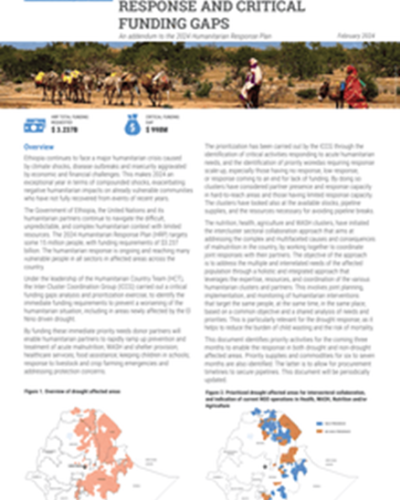Priority Humanitarian Response and Critical Funding Gaps

Ethiopia continues to face a major humanitarian crisis caused by climate shocks, disease outbreaks and insecurity aggravated by economic and financial challenges. This makes 2024 an exceptional year in terms of compounded shocks, exacerbating negative humanitarian impacts on already vulnerable communities who have not fully recovered from events of recent years.
The Government of Ethiopia, the United Nations and its humanitarian partners continue to navigate the difficult, unpredictable, and complex humanitarian context with limited resources. The 2024 Humanitarian Response Plan (HRP) targets some 15 million people, with funding requirements of $3.237 billion. The humanitarian response is ongoing and reaching many vulnerable people in all sectors in affected areas across the country.
Under the leadership of the Humanitarian Country Team (HCT), the Inter-Cluster Coordination Group (ICCG) carried out a critical funding gaps analysis and prioritization exercise, to identify the immediate funding requirements to prevent a worsening of the humanitarian situation, including in areas newly affected by the El Nino driven drought.
By funding these immediate priority needs donor partners will enable humanitarian partners to rapidly ramp up prevention and treatment of acute malnutrition; WASH and shelter provision; healthcare services; food assistance; keeping children in schools; response to livestock and crop farming emergencies and addressing protection concerns.
The prioritization has been carried out by the ICCG through the identification of critical activities responding to acute humanitarian needs, and the identification of priority woredas requiring response scale-up, especially those having no response, low response, or response coming to an end for lack of funding. By doing so clusters have considered partner presence and response capacity in hard-to-reach areas and those having limited response capacity. The clusters have looked also at the available stocks, pipeline supplies, and the resources necessary for avoiding pipeline breaks.
The nutrition, health, agriculture and WASH clusters, have initiated the intercluster sectoral collaboration approach that aims at addressing the complex and multifaceted causes and consequences of malnutrition in the country, by working together to coordinate joint responses with their partners. The objective of the approach is to address the multiple and interrelated needs of the affected population through a holistic and integrated approach that leverages the expertise, resources, and coordination of the various humanitarian clusters and partners. This involves joint planning, implementation, and monitoring of humanitarian interventions that target the same people, at the same time, in the same place, based on a common objective and a shared analysis of needs and priorities. This is particularly relevant for the drought response, as it helps to reduce the burden of child wasting and the risk of mortality.
This document identifies priority activities for the coming three months to enable the response in both drought and non-drought affected areas. Priority supplies and commodities for six to seven months are also identified. The latter is to allow for procurement timelines to secure pipelines. This document will be periodically updated.




















